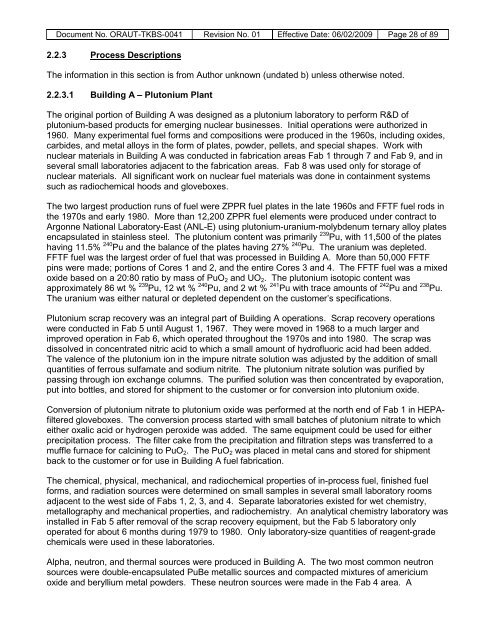ORAU TEAM Dose Reconstruction Project for NIOSH
ORAU TEAM Dose Reconstruction Project for NIOSH
ORAU TEAM Dose Reconstruction Project for NIOSH
Create successful ePaper yourself
Turn your PDF publications into a flip-book with our unique Google optimized e-Paper software.
Document No. <strong>ORAU</strong>T-TKBS-0041 Revision No. 01 Effective Date: 06/02/2009 Page 28 of 89<br />
2.2.3<br />
Process Descriptions<br />
The in<strong>for</strong>mation in this section is from Author unknown (undated b) unless otherwise noted.<br />
2.2.3.1 Building A – Plutonium Plant<br />
The original portion of Building A was designed as a plutonium laboratory to per<strong>for</strong>m R&D of<br />
plutonium-based products <strong>for</strong> emerging nuclear businesses. Initial operations were authorized in<br />
1960. Many experimental fuel <strong>for</strong>ms and compositions were produced in the 1960s, including oxides,<br />
carbides, and metal alloys in the <strong>for</strong>m of plates, powder, pellets, and special shapes. Work with<br />
nuclear materials in Building A was conducted in fabrication areas Fab 1 through 7 and Fab 9, and in<br />
several small laboratories adjacent to the fabrication areas. Fab 8 was used only <strong>for</strong> storage of<br />
nuclear materials. All significant work on nuclear fuel materials was done in containment systems<br />
such as radiochemical hoods and gloveboxes.<br />
The two largest production runs of fuel were ZPPR fuel plates in the late 1960s and FFTF fuel rods in<br />
the 1970s and early 1980. More than 12,200 ZPPR fuel elements were produced under contract to<br />
Argonne National Laboratory-East (ANL-E) using plutonium-uranium-molybdenum ternary alloy plates<br />
encapsulated in stainless steel. The plutonium content was primarily 239 Pu, with 11,500 of the plates<br />
having 11.5% 240 Pu and the balance of the plates having 27% 240 Pu. The uranium was depleted.<br />
FFTF fuel was the largest order of fuel that was processed in Building A. More than 50,000 FFTF<br />
pins were made; portions of Cores 1 and 2, and the entire Cores 3 and 4. The FFTF fuel was a mixed<br />
oxide based on a 20:80 ratio by mass of PuO2 and UO2. The plutonium isotopic content was<br />
approximately 86 wt % 239 Pu, 12 wt % 240 Pu, and 2 wt % 241 Pu with trace amounts of 242 Pu and 238 Pu.<br />
The uranium was either natural or depleted dependent on the customer’s specifications.<br />
Plutonium scrap recovery was an integral part of Building A operations. Scrap recovery operations<br />
were conducted in Fab 5 until August 1, 1967. They were moved in 1968 to a much larger and<br />
improved operation in Fab 6, which operated throughout the 1970s and into 1980. The scrap was<br />
dissolved in concentrated nitric acid to which a small amount of hydrofluoric acid had been added.<br />
The valence of the plutonium ion in the impure nitrate solution was adjusted by the addition of small<br />
quantities of ferrous sulfamate and sodium nitrite. The plutonium nitrate solution was purified by<br />
passing through ion exchange columns. The purified solution was then concentrated by evaporation,<br />
put into bottles, and stored <strong>for</strong> shipment to the customer or <strong>for</strong> conversion into plutonium oxide.<br />
Conversion of plutonium nitrate to plutonium oxide was per<strong>for</strong>med at the north end of Fab 1 in HEPAfiltered<br />
gloveboxes. The conversion process started with small batches of plutonium nitrate to which<br />
either oxalic acid or hydrogen peroxide was added. The same equipment could be used <strong>for</strong> either<br />
precipitation process. The filter cake from the precipitation and filtration steps was transferred to a<br />
muffle furnace <strong>for</strong> calcining to PuO2. The PuO2 was placed in metal cans and stored <strong>for</strong> shipment<br />
back to the customer or <strong>for</strong> use in Building A fuel fabrication.<br />
The chemical, physical, mechanical, and radiochemical properties of in-process fuel, finished fuel<br />
<strong>for</strong>ms, and radiation sources were determined on small samples in several small laboratory rooms<br />
adjacent to the west side of Fabs 1, 2, 3, and 4. Separate laboratories existed <strong>for</strong> wet chemistry,<br />
metallography and mechanical properties, and radiochemistry. An analytical chemistry laboratory was<br />
installed in Fab 5 after removal of the scrap recovery equipment, but the Fab 5 laboratory only<br />
operated <strong>for</strong> about 6 months during 1979 to 1980. Only laboratory-size quantities of reagent-grade<br />
chemicals were used in these laboratories.<br />
Alpha, neutron, and thermal sources were produced in Building A. The two most common neutron<br />
sources were double-encapsulated PuBe metallic sources and compacted mixtures of americium<br />
oxide and beryllium metal powders. These neutron sources were made in the Fab 4 area. A

















